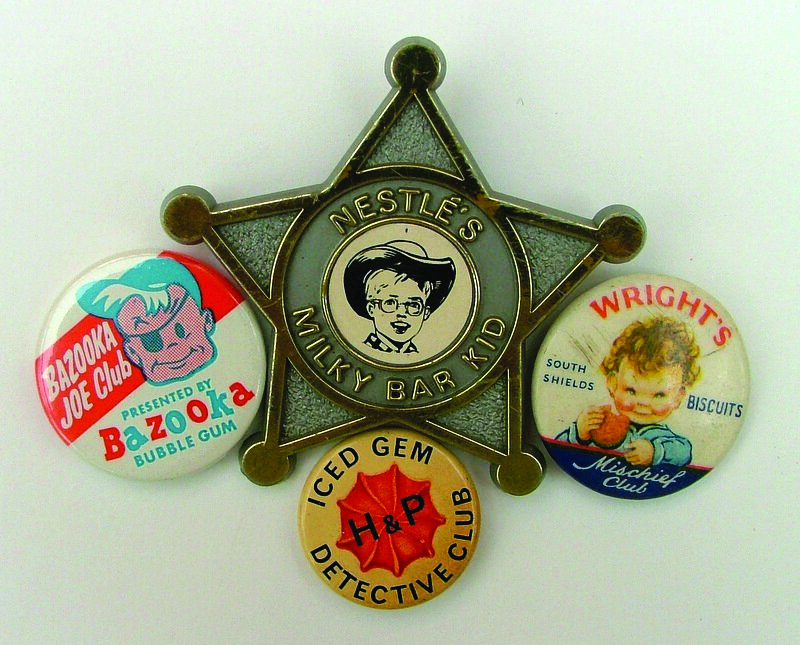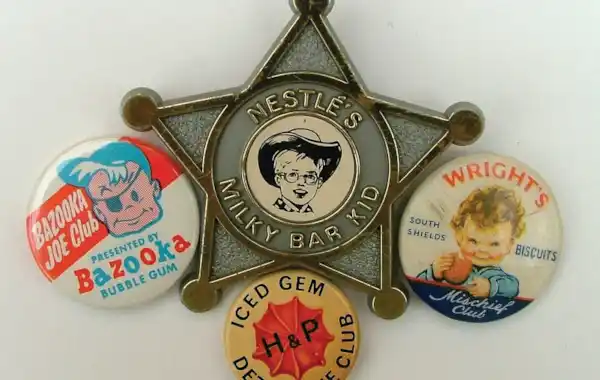19 February 2025
|
Collecting children's club badges can become nostalgic for many collectors, each one has its own unique story to tell.
Written by Brian Howes.
What Were the Most Popular Children's Clubs in the 1950s and 1960s?
Back in the 1950s and 1960s, there was no shortage of children’s clubs to join. The Bridgnorth Stamp Club was always one of my favourites along with the Airfix Modellers Club and the Boy Scouts, which I suppose, you have to call a kind of club really.
Are Vintage Cinema Club Badges Valuable?
My Saturday mornings were almost always spent at a children’s cinema club of some sort or another where you were signed up to be an ABC Minor, a STAR Young Citizen, a GRANADA Grenadier or an Odeon National Club Kid, depending on who owned the local flicks.
Suggested article: Are Beatles Trains the Perfect Collectable?
These cinema club badges were prolific and varied greatly in design, being made throughout many decades. They can easily be developed into a specialist area of collecting in their own right because there are so many. Some of those issued by ABC and STAR cinemas in the 1950s had a luminous white area or circle on them that glowed in the dark – wow that was a real novelty back in those days!

Which Ice Cream Brands Had Collectible Club Badges?
Ice cream, of course, has always been closely linked with the cinema and with kids in general, so there was no shortage of clubs for those of us who loved a lolly or cornet during the hot summer months.
Wall’s developed its Sky Ray Moon Fleet while the Lions Maid Galaxy Patrol enlisted Astral Majors, Squadron Commanders and Air Zone Defenders to its ranks. Even small-town ice cream makers like Rossi’s of Southend-on-Sea joined the ice cream space age revolution launching the Rossi’s Space Club with a series of rocket-related lapel badges.
By contrast, Meddocream Ltd linked up with the popular radio and TV show Educating Archie to launch its Archie Andrews Lollie Club. This attractive badge has become scarce over the years and remains much sought after by collectors. Other TV and radio-related clubs included the Tingha and Tucker Club, Famous Five Club and the ubiquitous Ovaltiney’s – possibly the biggest children’s club of them all, in its prime.
How Did Road Safety Clubs Like the Tufty Club Influence Badge Collecting?
Some clubs were firmly aimed at road safety issues as Britain’s roads became ever more hazardous during the post-war boom in car ownership. Remember those Tufty Club badges? Tufty was enlisted to lead children safely across Britain’s roads as far back as 1961 and lasted well into the 1980s, by which time the Tufty Club had recruited almost 25,000 members.
As a result, collectors will never consider these badges scarce. Advertising commercial products were the key aim of many children’s clubs. Horlick’s achieved this by launching its Spacemen’s Club and sending out smart plastic spaceship badges to members, which are now highly desirable both to badge collectors and advertising enthusiasts alike.
Huntley and Palmers recruited thousands of kids to its Iced Gem Detective Club, while Nestle assembled an army of would-be cowboys and girls led by the one and only Milky Bar Kid. More obscure clubs included the Wrights Biscuits Mischief Club and Armitage Gussie Club.
Clark’s Shoes produced a splendid enamel badge in the shape of a horse-shoe to members of its Lucky Two-Shoe Club and a special fixing beneath the badge accommodated a hanging pair of shoes, although these are often missing. Bubble gum lovers who enjoyed the delights of Bazooka Joe’s tasty offerings could send off a dozen or so gum wrappers to become a member of the Bazooka Joe Bubble Gum Club, and boy, was bubble gum popular in the 1960s!
What Newspaper and Comic Clubs Issued Badges?
National and local newspapers were always aware of the benefits of running children’s corners, clubs and circles. Among them were the Sunday Referee Shirley Temple League and the Daily Herald Bobby Bear Club, both of which issued lovely enamel badges, which are worth hunting for.
Meanwhile, comics and clubs went hand-in-hand for decades with badges being issued to children by Judy, Lion, Bunty and Girls Crystal to name just a few.
Holiday camps were also keen to see the merits of Children’s Clubs and badges can be found for the delightfully named Warner’s Wagtails, Pontins Coot Club, Squires Gate Junior Buccaneers and the Morecambe Bay ‘Saints’ and ‘Sinners’, among a host of others.
Mention should also be made of the various Ian Allan spotters clubs for those interested in trains and buses and, of course, the collectors clubs launched by many toy makers including Dinky, Corgi and Hornby, who all issued lapel badges to members.
What Are the Most Mysterious Children's Club Badges?
As in any sphere of collecting there are many mystery items that appear from time to time and there are, not surprisingly, clubs about which little is known. These include the Little Woody Children’s Club and the Happy Lion Clean Teeth Club. That’s the fun about collecting children’s club badges – you never know what interesting and obscure badges might turn up next and it’s great fun doing the necessary research to learn about them.
How Much Are Vintage Club Badges Worth Today?
The value of many of these badges is rising steadily and they are proving to be a good investment, as well as a fun thing to collect. Expect to pay anything from £3 for a common button and up to £50 for a scarce enamel. Generally speaking, the enamelled badges will command higher prices than button badges, however, a nice clean and rare pre-war button badge with a pictorial image will always give an enamel badge a run for its money.
Toy collectors can get the latest collecting news by signing up for the Collectors Club of Great Britain’s newsletter.







